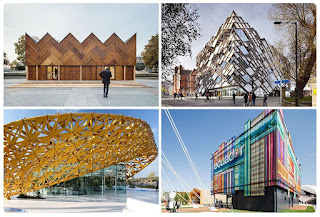First Impressions
I
think the notion of façade versus interior design is such an interesting one,
because it is not often that both are experienced simultaneously. People engage with building very differently
depending on whether they are on the interior or exterior. Additionally, it is also seems that the design
of interior spaces are becoming increasingly left to that of the end user –
with the notion of flexibility and adaptability playing a major role in the
original design. This is not generally
the case for the façade. This causes me
to reflect on the question: is it really necessary that the interior and
exterior perfectly reflect each other – or even that they are both designed by
the same architect or firm? It was discussed in class that several of us have
worked at firms where we have just been commissioned to do one or the other. And I personally don’t know that I find
anything wrong with this.
More often than not, I think your first impression of a building (generally the façade), is what determines your level of desire to explore it further – whether it be a public/community building, an apartment complex, or a restaurant. First impressions are everything, and if the building facade does not give off a good one, it is likely that the interior won’t matter quite as much to an individual at that point. I love this idea David mentioned in class of the “envelope as a mediator with the exterior”. I know, personally, as I am on the hunt for a new apartment, I form an immediate opinion about the building the minute I drive by it on the street. I consider the way the space around the exterior perimeter of the building is used – the ways in which the facade interacts with the site to create exterior public and private spaces which ultimately relate to the level of safety I feel. Of course, both the interior and exterior of a building plan a vital role in how that building is experienced and used every day: the interior arguably more so. I guess my point is that you are not going to care so much what the exterior of the building looks like when you are inside it and, likewise, are probably not going to concern yourself too much with the interior layout when walking past a building on the street. So is it really necessary that the two designs perfectly reflect each other?


I get your point about the exterior and interior speaking different languages. I am currently looking at apartments and there are so many that I want to write off right off the bat because the exterior looks bad or old or whatever...then you look at the interior pictures and you're like really? why is it so nice with such a grungy exterior. I mean my opinion gets swayed sometimes on an apartment building once I realize what the interior looks like, but I guess I wish they could reflect each other a little bit more sometimes?
ReplyDelete